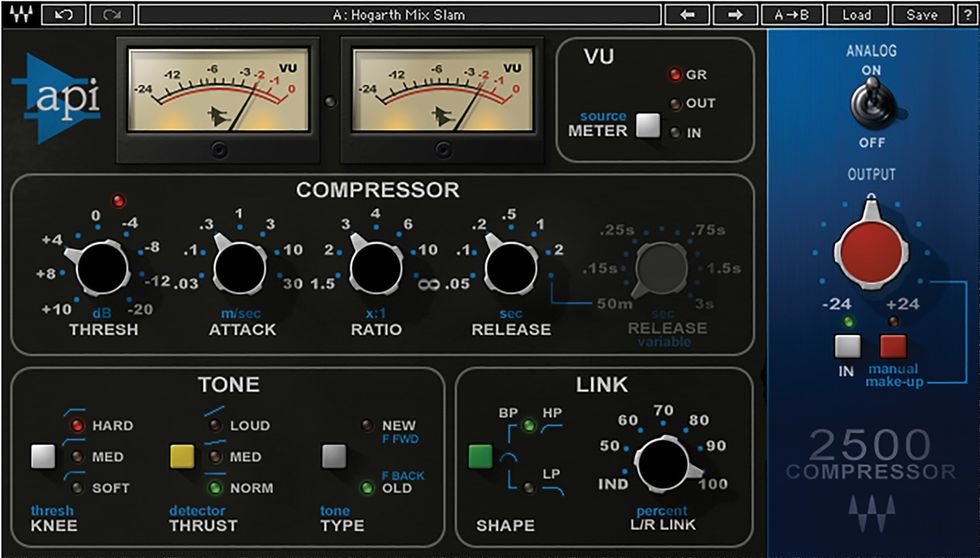Welcome to the second installment of the Recording Dojo. If you missed last month's column, I encourage you to go read it for a deeper understanding of my devised acronym: TKARR. Now, tighten up your belts. The dojo is open.
I will break down four classic compressors and give you basic settings to try on your audio that should inspire you to experiment and refine. That's right: experiment! Don't be scared.
In part one, I explained the five “party" parameters of compression: threshold, knee, attack, ratio, and release (TKARR). Basically, that's the order of how audio is processed inside any compressor, regardless if it's a plug-in or analog. While there are hundreds of compressors (and ever-multiplying variants), not all of them allow the user to adjust all five parameters, which contributes to the confusion about compression. Let's put that knowledge to work by examining some classic, industry-standard compressors and their user controls (GUIs).
But first, I want to address a question posed by some of the blue belts: “What's the difference between a compressor and a limiter?" Ratio. Anything higher than a 10:1 ratio is traditionally classified as a limiter by audio sensei worldwide. Simple.
So, up first is the most minimal of the group: the Teletronix LA-2A. Tube-based, this unit sounds great on just about everything … especially bass, acoustic guitars, and vocals. Notice that all five TKARR elements are deftly summed into one knob labeled Peak Reduction. Everything is fixed except switching between compressor or limiter mode—and you now know what that means! Try putting this device on limit mode, crank the Peak Reduction knob until that electric bass starts to feel solid, strong, and keeps the bottom end in check.
Arguably one of the most widely used compressors of all time is the Universal Audio 1176, and there have been many versions throughout the years. Introduced in 1967 as the first solid-state, true-peak limiter, the two most emulated and popular versions are the “blue stripe" (revisions A and AB) and the “blackface" (revision E).
With this unit, you'll notice that you have control over attack and release (1 = slowest, 7 = fastest), ratio (four choices), and threshold (cleverly disguised as Input), but no knee. These compressors have extremely fast attack times and can scalp a massive snare drum hit to a tiny pop. One classic trick is to push (or shift+select) the 20:1 ratio knob and the 4:1 ratio knob (aka the “all" button). Put this on your drum bus and bam—instant epic rock 'n' roll drums. For guitars and vocals: attack 3-4, release 6-7. Season to taste.
Often regarded as the holy grail of compressors, the Fairchild 670 (stereo) and 660 (mono) are loaded with transformers and glorious tubes (20 for the 670). A Fairchild sounds great on everything and is widely emulated by many manufacturers: Waves, IK Multimedia, and Universal Audio to name a few. Because of the temperamental nature of the analog units, I prefer to use plug-ins most of the time, especially for mixing. The Fairchild circuit design is very complex, so don't let the deceptively simple faceplate (GUI) fool you—even though only one element of TKARR, threshold, is listed. For example, the time constant knob combines attack and release into six set positions. Attack times range from .02 ms to .08 ms, and the release times get longer as you move from 1 to 6. Try this: Put a 670 on your main mix bus, set time constant to 2, crank the input gain, and adjust the threshold until you get 3 dB of compression—and hear how your mix starts to glue together.
The classic API 2500 has huge flexibility and even boasts a stepped, adjustable knee function.
Finally, let's look at another classic that has all five elements: the API 2500. This compressor has huge flexibility and even boasts a stepped, adjustable knee function. The API has a huge, punchy sound and has been a go-to compressor for decades. Put it on your master bus or use it on distorted guitars, electric bass, and drums. I also like it on vintage drum machines and vintage synths of all kinds. Try this on your favorite lead synth patch: Set the knee to hard, set the type to new, ratio to 4:1, release to 0.2, and adjust the threshold and attack to taste. You should get some nice added punch!
Experimenting with these suggestions should keep you busy at least until next month!













![Rig Rundown: Russian Circles’ Mike Sullivan [2025]](https://www.premierguitar.com/media-library/youtube.jpg?id=62303631&width=1245&height=700&quality=70&coordinates=0%2C0%2C0%2C0)







